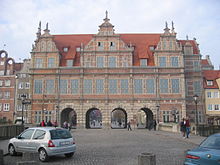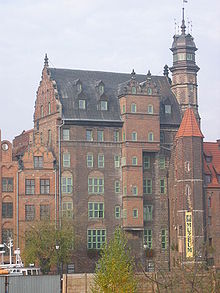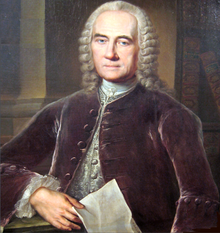- Danzig Research Society
-
The Danzig Research Society (German: Naturforschende Gesellschaft in Danzig, Latin: Societas Physicae Experimentalis, Polish: Gdańskie Towarzystwo Przyrodnicze) was founded in 1743 in the city of Danzig (Gdańsk). The Societas Physicae Experimentalis (Experimental Physics Society), later renamed to Naturforschende Gesellschaft (Nature-research-conducting Society), is thus considered as one of the oldest research societies in Central and Eastern Europe.
Already in 1670, the physician Israel Conradi (1634–1715) had tried to organize a scientific society in Danzig, without success yet. Several others tried after him, until the Privatdozent Daniel Gralath (1708–1767) finally succeeded. His father-in-law was Jacob Theodor Klein (1685–1759), a city secretary and also a very distinguished scientist, nicknamed Gedanensium Plinius.
At the end of 1742, Gralath had gathered a group of learned men for his purpose, an Experimental Physics Society (Societas Physicae Experimentalis), one of the oldest research societies in German-speaking parts of Europe. The first organizing meeting took place on 7 November 1742, the first scientific meeting was called on 2 January 1743. The aim of the Society was to practice and popularize science, among others through weekly public demonstrations of the most interesting experiments in physics. Often the effects of electricity were studied, with the help of the Leyden jar. Since 1746 these took place in the Great Hall of the Green Gate building. Gralath also became Ratsherr (councilman) and, in 1763, Bürgermeister (mayor) of Danzig.
Known members were Nathanael Matthaeus von Wolf, Michael Christoph Hanow, Gottfried Lengnich, Johann Jacob Mascov, who wrote Geschichte der Teutschen, also Daniel Gabriel Fahrenheit and the prince-bishop Adam Stanisław Grabowski of the noble Götzendorff-Grabowski family.
The sessions of the Society were also attended by many famous persons of the Polish-Lithuanian Commonwealth like Great Lithuanian Hetman Michał Kazimierz "Rybeńko" Radziwiłł, August Fryderyk Moszyński, Joachim Chreptowicz.
In 1840 Alexander von Humboldt accompanied Prussian King Frederick William IV on the way to Königsberg, and Humboldt received an honorary membership in the Society. Later, the society offered Humboldt stipends. The collections of the Society were displayed in the West-Prussian Provincial Museum located at the Green Gate.
In 1845 the society was located in a Renaissance-era building at the Mottlau (Motława), an arm of the Vistula River.
After 200 years of existence, the society ceased to exist when the German citizens of the Free City of Danzig had to leave. Also, its building and many priceless valuables[1] were destroyed during the Soviet offensive in 1945, two years after the 200th anniversary.
The building at the Motława river was rebuilt after the war. It houses an Archaeological Museum [2] today.
References
- List of publications by Naturforschende Gesellschaft in Danzig
- E. Schumann, History of the Research Society in Danzig 1743–1892 (Geschichte der Naturforschenden Gesellschaft in Danzig 1743–1892)
- (English) Andrzej Januszajtis, Scientists in Old Gdansk
Categories:- 1743 establishments
- 1945 disestablishments
- Scientific societies
- Buildings and structures in Gdańsk
- History of Prussia
- History of Gdańsk
- History of Germany
- History of Poland
Wikimedia Foundation. 2010.



